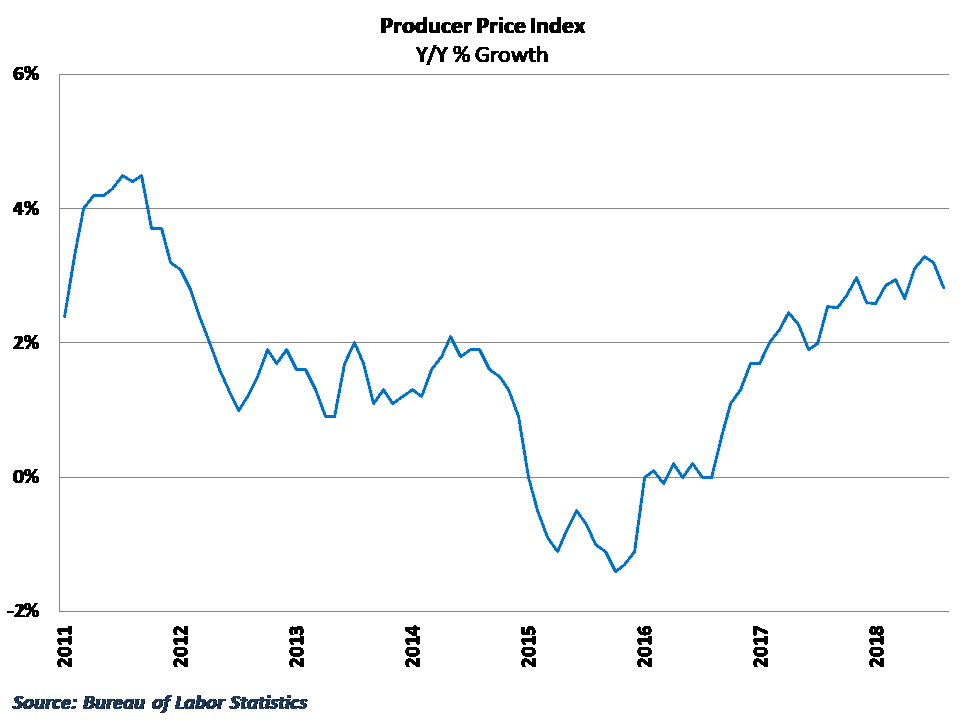Data on producer prices shows that overall inflation pressure eased further in the 3rd quarter, declining for the first time in 18 months. Trucking prices also calmed during the month, as big declines in long-distance trucking and LTL rates offset rising rates among local carriers.
The Bureau of Labor Statistics reported that the producer price index (PPI) was declined 0.1% in August after remaining flat in the previous month., falling short of expectations of a 0.2% gain. Year-over-year wholesale inflation has retreated back under 3% after reaching multi-year highs in June of this year

Much of the decline during the month was driven by a fall in food prices, as goods such as eggs and fresh fruits saw a fall in prices in August. This helped to offset a gasoline-led increase in energy prices, and led to the first decline in the headline PPI reading since February of 2017. The core PPI, which strips out food, trade services, and energy, actually rose 0.1% during the month and is now 2.9% higher than at this point last year.
Many have been paying attention to producer price data in recent months in search of signs that recent trade spats and rising commodity prices would begin filtering into the broader economy. This morning’s results would suggest that things may have calmed after some early tariff-related increases. As the number of implemented tariffs gets ratcheted up, however, expectations are that this will begin to filter into the broader economy through higher inflation in upcoming months.
Trucking slip after records high in long-distance trucking
Data on trucking rates also showed the first decline in over a year, as PPI readings from general freight trucking fell 0.3% in August from July’s levels. This comes on the heels of three consecutive months of gains over 1% in the industry, pushing year-over-year growth down to 8.4%

The decline within trucking during the month was driven largely by long-distance services. Long distance truckload rates slipped 1.4% in August, while LTL long distance rates were essentially flat during the month. Year-over-year growth fell to 8.6% for long-distance trucking rates, down from a record-high 11.6% growth in the previous month. LTL long distance growth slipped to 7.3% in August, down from 7.5% in the previous month
These declines, offset a large increase in local trucking rates, which jumped 2.7% from July’s levels. This was the largest monthly gain in local trucking in over a decade and caused year-over-year to rise to 8.8%.
Behind the Numbers:
The headline PPI numbers again fell short of expectations, both for the headline number and the core PPI reading stripping out food and energy. Survey data from manufacturing businesses suggests that some of the early surges in steel and aluminum prices in the aftermath of tariff announcements has calmed down, so some of the softness in PPI could be reflective of some sanity returning to these markets. Still, the pace of actually implemented tariffs is beginning to pick up, and there have been no shortage of threats from the administration, so this kind of tariff-related noise is likely to subtly push the inflation readings in one direction or another in upcoming months.
On the trucking side, there were some pretty big swings in the truckload numbers, but some of it just feels like a bit of a correction in the data. Long distance truckload rates had been posting some gaudy increases over the past few months, and August results appear to be a bit of payback from this earlier surge.
In addition, the year-over-year growth numbers ran into some tough comps to last August, where Hurricane Harvey began a series of big increases in the rates. These tough comps are going to continue in September, but the impending landfall of Hurricane Florence will also likely boost trucking rates this year.
Weather-related fluctuations aside, conditions are still generally tight in freight markets. Rate inflation may settle some as the comparisons get more difficult to last year, but should remain high as we round out the year.
Ibrahiim Bayaan is FreightWaves’ Chief Economist. He writes regularly on all aspects of the economy and provides context with original research and analytics on freight market trends. Never miss his commentary by subscribing.







